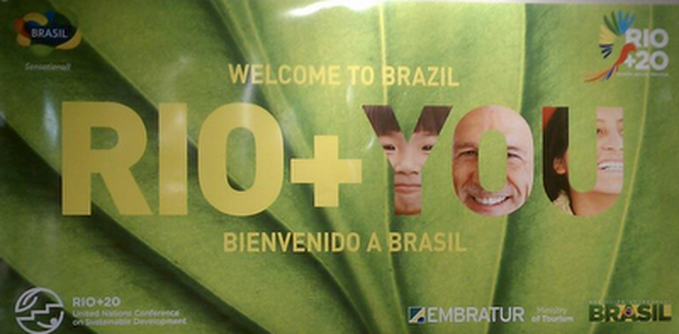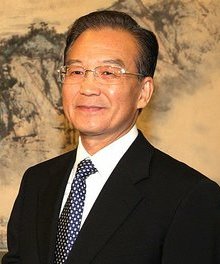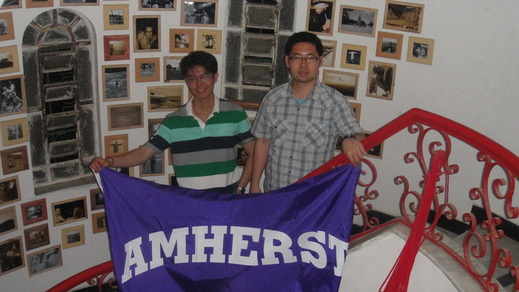 Tuesday June 12, 2012:
We (Shane and Julian) did not have a very smooth trip from Amherst to Rio. George had already arrived in Rio three days prior, and had reported by the second day that his cell phone was snatched away by a motorcycle-ridden robber. The Peter Pan bus ride to New York flew by with dreamy thoughts. Our journey started getting cranky in New York. After a quick, late lunch in a Sbarro’s, we emerged from the restaurant to find that we were trapped by a downpour, having nary a hope of trudging to the subway station without being completely drenched by the weeping sky. We then spotted a shuttle was parked mere yards away from where we were shivering, and after a brief inquiry found out that it was the shuttle to Grand Central station. Too bad it was already full. We waited and waited and waited, and finally the shuttle came – it was a Mercedes! We hopped in after learning it would bring us to Grand Central for free. At Grand Central, we dashed off towards a sudden call of “JFK Shuttle!”by a large woman standing close to a white shuttle, with our luggage after us, the tip off our minds, and with a wide-eyed driver incredulous at our hurriedness and lack of gratuity.
This second shuttle happened to take almost two hours to get from Grand Central to JFK, our anxious glances at our watches accentuated by the hysterical chattering of two French women seated in front of us who were apparently only 40 minutes away from their flight. Well, we weren’t too much better off, with a little over an hour to spare as we sped off towards the terminal entrance. It wasn’t before we were physically seated in the airplane’s cabin that we could take a relaxed breathe.
The first leg of the flight was from JFK to Sao Paolo, and went through without much incident. My initial drowsiness disappeared as the icon for the movie “Sherlock Holmes 2” appeared on the small seatback screen. I admired Holmes’s wit and fighting skills for two hours before dozing off.
The next morning brought another bad turn. During a 3 hour layover in the Sao Paolo airport, I (Julian)was almost cheated out of $1000 by the money changer, and then we had to sit in two similarly stuffy airplanes for about two hours because the first plane’s brake was discovered to have been malfunctioning and the second plane’s crew had to switch off with the first plané’s because of some mysterious documentation issue. After a 2.5 hour delay, we finally lifted off again, only to come back down to earth in about an hour and 20 minutes.
The cab ride from the airport was an experience. It was quite ironic that we were in Rio de Janeiro for a Conference on Sustainable Development, but for quite some time the air in the miles adjoining the airport was smoggy and noxious. After close to two hours of being stuck in traffic horrible enough to be reminiscent of Los Angeles, and another 15 minutes’ meandering on muddy roads that populate the foothills near our hostel, we finally got out and had our feet on terra firma.
The road was Rua Ary Barroso, which pointed to a steep windy path of a road. After exchanging glances of doubt, we started ascending the slosh-filled path with our luggage. Once the path diverged and we took the wrong turn, only being directed in the correct direction after a valiant effort from a middle-aged construction worker. Oh, and did I mention that much of the muddy path was littered with construction material thanks to a high-decibel renovation job that runs from 7AM to 5 PM daily right outside our hostel window? At any rate, we finally, with heavy breathes and soaked clothing thanks to the sweltering weather (yes, winter in Rio can still be sweltering), trudged into our hostel lobby, where we were re-united with our comrade George. When George came back to the hostel at around 5PM, we realized we hadn’t eaten since 4 AM, and proceeded to drag George out of the hostel and onto the streets to stare at us munching down spaghetti and salmon and fries. We enjoyed the short walk from our hostel to the Copacabana beach, and joked and chatted freely. The relaxing times won’t be long. George, Shane and I are bracing for the serious work – the hectic and sustained dosage of emails, power points, speeches, interviews, side events, and articles starts tonight.
 Created on Sunday, 10 June 2012 03:10 Last Updated on Sunday, 10 June 2012 22:08 Written by Adam Hasz (SustainUS)
Next week, the world will converge in Brazil for the United Nations Conference on Sustainable Development, aka the Rio+20 Earth Summit. If you are in the United States, you may never have heard of this conference. Well, it's time to start paying attention. The policies, partnerships, and initiatives that emerge from Rio+20 have the potential to change the world and put us on a much more sustainable path.
In short, Rio+20 is a conference designed to reaffirm the world's commitment to sustainable development. Sustainable development means different things to different people, but the most known definition is "meeting our present needs without compromising future generations’ ability to meet their own needs." Understanding sustainable development this way means that economic production must occur in socially just manner (meeting the needs of the present generation) while not degrading the Earth's planetary ecosystems beyond their regenerative capacity (ensuring that future generations will also have clean air, clean water, productive soil, and a stable climate). Sounds simple, right?
Unfortunately, we're a long way from actually achieving sustainable development. Our current development system is great at creating economic production, leading to remarkable advances in technology and quality of life. However, our current system is not achieving social justice or ecological sustainability: nearly 3 billion people still live on less than $2 per day, and we would need 1.5 planets to sustainably regenerate all of the resources we consume globally each year. And while we are quite good at creating economic wealth, we still have a lot of room in improving our ability to cultivate happiness. Record numbers of people currently suffer from depression, anxiety, and other mental illnesses, and according to the World Health Organization, more people die from suicide annually than from homicides and wars combined. With these statistics in mind, world leaders are gathering in Rio de Janeiro to try to work out a new development pathway that balances economic production with social and ecological well-being. They also tried this twenty years ago, at the original Rio Earth Summit in 1992. While the documents and ideas that emerged were inspiring, the implementation of sustainable development during the past twenty years was fairly disappointing. Hence the "+20" in the Rio+20 conference title; this year's meeting is an attempt to reboot the international dialogue and move global development towards sustainability twenty years after the original Earth Summit. Over 130 heads of state are committed to attend the conference, and UN Secretary Ban Ki-Moon is hopeful that Rio+20 will serve as a major turning point for the global community. Policy agreements from Rio+20, however, likely won't be the most important thing that emerges from the conference. Governments simply aren't powerful enough to create the global transformation necessary for sustainable development; the transition also needs leadership from business and civil society. Rio+20 is an incredible opportunity for these groups to share their success stories, demonstrate proven models for local sustainable development, and build the broader coalitions necessary to create deep political, economic, and cultural change. For me, the most exciting opportunity for Rio+20 is the concentration of innovative ideas and proven models for local and regional sustainable development. There is a whole ecosystem of side events and side conferences happening alongside the official UN process: from a forum on social entrepreneurship to a TEDx event on “human power” to the “people’s summit” for sustainable development, there are many opportunities to engage in productive dialogue about the future of our planet and our global society. These events will host critical conversations, but they won’t have an impact unless the message reaches communities around the world. That’s where you all come in. Anyone reading this blogpost (and anyone informed about Rio+20 and sustainable development) has incredible power; you hold the information and the influence needed to change the conversation about development. In the long run, we need major policy changes and institutional reforms to redirect resources in a more sustainable manner. But none of this can happen without the hard work of having intentional conversations with our friends, neighbors, family, and co-workers. Sustainability is a global issue, but deep social change almost always occurs on a local scale. The truth is, Rio+20 will not usher in a new era of sustainability. The policy document that emerges from Rio+20 will likely be very weak, filled with greenwash or half-measures with little to no accountability. While over 100 heads of state are attending, they will likely offer lots of rhetoric and little new initiatives. Yet, Rio+20 does offer a rare opportunity to challenge the status quo model of development and question fundamental assumptions (like economic growth can continue forever or that the huge discrepancies between the rich and the poor are an inevitable side effect of economic progress). The change in the status quo requires a collective change of mindset, and change that can begin by engaging our communities on the tough issues of sustainable development. We have the power to create a more sustainable world. And we can start to bring this new world into being, one conversation at a time.
 This post is co-authored with Dr. Yang Fuqiang, Senior Advisor on Climate and Energy at NRDC, Beijing. In less than two weeks, Chinese Premier Wen Jiabao will join as many as 135 heads of state and 50,000 participants at the Rio+20 Earth Summit. The first historic Earth Summit in 1992 was a turning point in China’s environmental awareness, catapulting sustainable development to a national priority. Now, as the twentieth year reunion nears, we need to capture this unique opportunity to make progress on a variety of issues, in particular climate change. Premier Wen should look past the contentious fight over the ballooning outcome document and focus on what matters most: action. Rio+20 is set to be one of the “largest and most important conferences in the history of the United Nations”, according to UN Secretary-General Ban Ki-moon. NRDC has been calling for over a year now that concrete actions and commitments should be the main outcome of this conference. A lengthy document without action does little to help move forward on important priorities for China and the rest of the world. We need to speed up deployment of renewable energy; make good on promises to phase down fossil fuel subsidies; mobilize investments in off-grid renewable energy; and much more. Rio+20, taking place one year into China’s most progressive five-year plan to date, can serve to highlight the continuing obstacles to sustainable development and showcase and scale up successful efforts. This is also an opportunity to enshrine internationally China’s 2015 targets for energy intensity, carbon intensity and other environmental indicators. Earlier this week the State Council released China’s National Report on Sustainable Development which provides some clues on the past twenty years. Now, looking forward, China should turn its attention to ensuring implementation of its own commitments. NRDC thinks these should start with: - Establish renewable energy quotas for grid companies and local governments
An essential element to ensure the sustainable growth of China’s use of renewable energy sources is the establishment of renewable energy quotas for grid companies and local governments. - Improve integration of renewable energy onto the grid
China should improve planning for renewable integration, establish appropriate grid connection standards for wind and solar, and develop energy storage and natural gas peaking plants in order to improve integration of renewable energy sources. - Improve financing mechanisms and policies for urban, distributed renewable energy deployment
In addition to promoting utility-scale applications, China should redouble efforts to develop distributed, rooftop solar PV in Chinese cities by setting appropriate incentives policies and encouraging the use of innovative financing models. - Improve measurement and verification of grid companies’ energy savings targets
In order to successfully enforce the new national demand-side management regulations (DSM), China should put in place transparent and effective measurement and verification mechanisms. - Phase out highly polluting diesel fuels in cars and trucks
China’s diesel problem can be tackled as it has been in other countries, by first focusing on production of cleaner-burning diesel fuels. By implementing standards and incentives to reduce sulfur in diesel fuel, China can reduce the environmental and health impact of its growing numbers of diesel vehicles. >> Read more details here. The future we want – to improve our global social and environmental well-being – rests in the balance as countries scramble with last-minute preparations for the summit. From China, over twenty private companies and several non-governmental organizations are gearing up to make commitments for the global gathering, showing action from the ground up. Similarly, across the world, we have been documenting new initiatives for the summit. Premier Wen and other leaders will be in the spotlight in Rio to set a far-reaching agenda that is both tangible and transformative. He can lead a renewed charge on implementation by reaffirming China’s domestic goals and to advance efforts to combat climate change and promote clean energy with concrete steps like these. Image credits: http://upload.wikimedia.org/wikipedia/commons/c/ce/Wen_Jiabao_%28Cropped%29.jpg
 We humankind live on a beautiful globe, yet we have repeatedly abused our relationship with nature and failed to appreciate the bountiful planet that has been ever so patient and generous in nurturing us, a strong yet fragile species.
The world is facing a mounting crisis. Under a combination of a global financial crisis, a food crisis, volatile oil prices, accelerating ecosystem degradation and an increasing number of climate-induced extreme weather events, compassion has risen and groups of people began to fight for their own rights to a better world. Behind these tragedies and efforts at redemption looms a theme of immeasurable importance: we must control and harness the forces which we have ourselves created. Every nation has its own right to reap appropriate benefits from what nature has to offer; but if these forces for the exploitation of the environment are allowed to suckle at Mother Nature’s breasts without restraint, Man’s insatiable desire will exhaust the Earth’s bounty and bring ruin upon itself. Burning issues such as the sustainable enrichment of humanities and ultimate concern for nature are now embodied by and etched into a proper noun whose prominence will rise in the coming weeks during RIO+20.
The story of Rio goes back to 1992. The U.N. Conference on Environment and Development (UNCED) realized that the ultimate goal of sustainable development could never be fully achieved by governments alone. Individuals from all walks of life — business sectors and industries, colleges and universities, labs and construction sites, as well as governments and non-governmental organizations — all need to play their parts in laying out and maintaining a sustainable path of development and enrichment for us and our offspring. The U.N. is again mustering officials, international institutions and major groups “to agree on a range of smart measures that can reduce poverty while promoting decent jobs, clean energy and a more sustainable and fair use of resources.” Society needs to advance, but with only with great wisdom, understanding and most important of all, vision. Anxious as we are to eliminate poverty, hunger, diseases, racial discriminations and glaring economic inequalities between classes, the crux of the problem is that we need a new, different approach towards ‘development.’ The environmental crises that have transpired represent the vengeance of nature upon greedy, unbridled plundering of the environment; how we interact with the Earth is a reflection of how qualified we are to be a part of this biosphere. On the 13th of June this year, the United Nations Conference on Sustainable Development (UNCSD) will commence preparatory meetings and dialogue on sustainable development, culminating in the official Summit on the 20th to 22nd of June 2012, celebrating the 20th anniversary of the Stockholm Conference on the Human Environment that took place in 1992 in Rio de Janeiro. These constructive sessions will take place at the Rio Centro Convention Centre with numerous side events occurring on the grounds of the Exhibition Centre. In addition, valuable opportunities for stakeholders to organize UNCSD-related activities will be available outside the Rio Centro Convention Center (so called off-site events) at various venues in the City of Rio de Janeiro. Nicknamed the Rio+20, or the Earth Summit 2012, due to the initial conference having been held in Rio in 1992, the primary objectives of the Earth Summit will be: securing extended political commitment to sustainable development, assessing progress towards internationally agreed goals on sustainable development and addressing new and emerging challenges. Two additional specific themes are also to be expounded at the conference: building a green economy in conjunction with poverty eradication and developing an institutional framework for sustainable development.
A number of auxiliary workshops are also to be delivered; meetings and events revolving around the summit will occur throughout Rio. Many of the formal events can only be attended by ‘Major Groups’ accredited and registered through the U.N.’s Economic and Social Council (ECOSOC), and armed with official ground passes. However, there will be extensive media coverage and numerous related events to keep the whole world informed. The future of Planet Earth will not be kept behind the walls of the convention halls; the severity of environmental degradation and any imminent or inevitable implications shall be fully discussed, freshly packaged and broadcasted around the globe.
Indeed, with myriad global environmental issues staring us in the face, we cannot afford to wait for the complete alignment of opinions and interests within and beyond the scientific and political sectors. Here, time is our enemy. Only through combining forces in tackling the same dire environmental issues, forging ahead in the same direction and pooling our creativity and resources in resolving the same crises can we recover the stunningly beautiful image of Earth in memories from halcyon days. The powerful image of Earth shot by astronauts in Apollo 11 presents an energetic, solitary, fragile sphere rising above the horizon of the moon, providing a home and sustaining the livelihood of all human beings. From this holistic and far-sighted (both figuratively and literally) perspective, it is impossible to discern the boundaries of nations and all the other artificial barriers that divide mankind. Our common dependence on the health of our Earth and our common interest in ensuring its responsible and sustainable stewardship transcend gulfs in nationality, race or religion. We must unshackle ourselves from our divisions, greed and fears to strive toward a common goal of resuscitating an already extenuated and overexploited Earth.
Co-Authors: Yunpeng Du, Xiangyu Zhao, and Ji An Wang
Note: This is an article published on the April 18, 2012 issue of The Amherst Student, the Amherst College newspaper.
Picture Credit: http://bathsavvy.files.wordpress.com/2012/04/earth911earthday-298x300.jpg
Start blogging by creating a new post. You can edit or delete me by clicking under the comments. You can also customize your sidebar by dragging in elements from the top bar.
|





 RSS Feed
RSS Feed